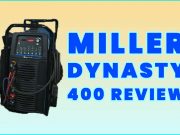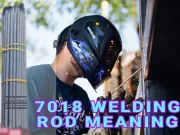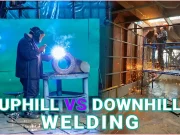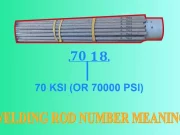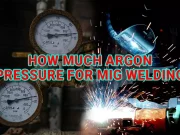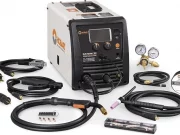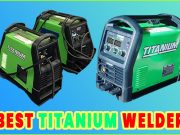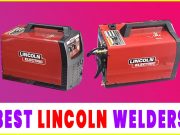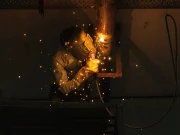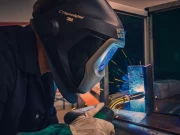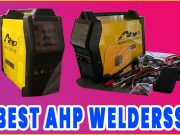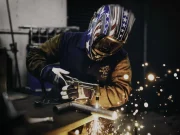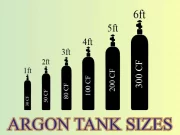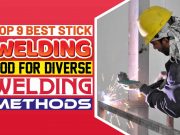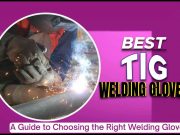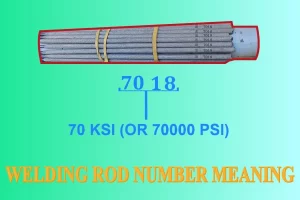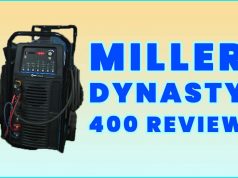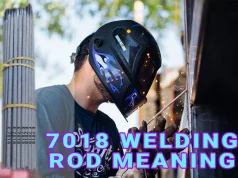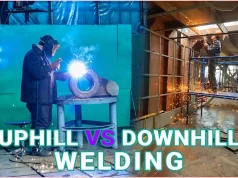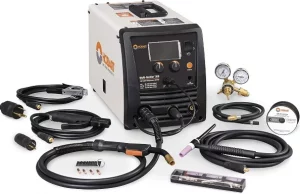Welding is a complicated profession, and there are many things you need to consider to make your job stand out. One of the most important considerations is the welding rod you use.
There are several welding rods, and they have numbers that can be confusing for someone that has never welded before.
Let us take a closer look at these rods and the numbers to understand what they mean and find the one that will work best for you;
Welding Rod Number Meaning
Welding rods have different properties, so there needed to be a system of naming electrodes that would make it clear what each electrode does.
This system came up in the form of a letter and four numbers along the side of each rod to identify it.
The numbers all have specifications about the rod and its use, so it is crucial to understand them. These markers are important to help you know which type of rod you are dealing with so let us take a look and see what they mean;
For this demonstration, we will use the E7018 since it is one of the most commonly used stick electrodes.
The letter E denotes an electrode, and there isn’t much to read from that; the most important aspect is the numbers.
The four numbers are in three groups, two numbers, and two single digits; the first two numbers represent the strength of the resulting weld. They show the lowest tensile strength you will get from the weld in pounds per square inch.
The tensile strength is the two numbers multiplied by 1000; for instance, in the E7018 rod, the electrode can produce a 70,000 psi tensile strength weld.
The third number is either 1 or 2, showing how many positions you can use the rod in. The number 1 shows you can use the rod in all positions, while 2 means you can only use it on horizontal and flat fillet welds.
The last number is for the coating used on the rod, and it is also an important fact to look into. 0 means it has a high cellulose sodium coating and it can only work with DC+, 1 is for high cellulose potassium, and it can work with AC, DC+, or DC-.
Number 2 and 3 are High Titania sodium and potassium coatings, and they work with AC, DC+ and AC, DC+ respectively. 4 has Iron powder and Titania coatings, which make it work with AC, DC+ or DC- while number 5 has a low hydrogen sodium coat that uses only DC+.
Number 6 has a low hydrogen potassium coating that uses AC and DC+, number 7 has high iron oxide and potassium powder coatings; thus, it works well with AC, DC+, and DC- and finally, 8 has a low hydrogen potassium and iron powder coating that works with AC, DC+ or DC-.
Putting all these into account, our example E7018 is an arch electrode whose weld will have a tensile strength of 70,000 psi, you can use it in all positions, and it has low hydrogen potassium and iron powder coating, so it welds using AC, DC+ or DC- welding currents.
Welders can tell which rods will be best for their work without knowing what they look like. There is a long list of electrodes using this system from E6010 to E7024; you only need to understand what you need from the rod and get the best one.
How To Get The Best Welding Rod
It would help if you considered crucial factors when looking for a welding rod, and missing out on this might lead you to the wrong product. Here are a few of the facts you have to think about when choosing a welding rod;
Base metal properties
You need to know what metal you want to weld before getting an electrode, and you need to match the electrode composition with your base metal.
The closer the weld and metal relate, the better the weld will hold since they have similar physical properties.
Tensile strength
Metals expand and contract depending on the changes in environmental temperatures. It would be best to get a rod with a tensile strength close to that of the base metal, so the weld and base metal expand and contract at the same rate.
If the two metals have different tensile strengths, they will expand and contract at different rates, which might cause a crack in the joint.
Welding current
Some electrodes can only work with AC or DC, while others work with both, so you need to know the current your welder produces and get a rod to match it. Refer to the fourth digit on the rod, which will show you the coating and compatible current.
The joint shape and thickness of base metal
You need to consider the thickness since it determines how much penetration you need from the rod.
If you get too much penetration, you will end up making holes in the base metal, and if you don’t get enough penetration, the joint won’t be strong enough.
Smaller diameter rods will give less penetration. Thus they will not be the best choice for thick plates that need deep penetration to take a firm hold.
If you work on a joint, get an electrode with a digging arch, so you get deep penetration on all sides for a sturdier joint.
The Best Welding Rods For Thin Metal
Working with thick metal is relatively easy, but it gets more complex as the metal gets thinner since you risk penetrating the metal.
You, therefore, need to know the right metal to use for the welding process, and here are some products you can try out;
1. Forney 30705 E7018 Welding Rod
This is a simple-to-use 5-pound product that will guarantee high-quality work in the right conditions.
You can use it to weld steels with thick joints, joints with cracks, general fabrication, and out-of-position welding.
It works perfectly for all steel, so you won’t need to worry too much about its effectiveness. This low hydrogen rod can work in all directions, and it will be a great help for any welder. You can use this rod on DC+ applications but not on a low OCV.
2. Hobart 770457 6011 Stick
This electrode offers you a weld with 60 000 psi tensile strength, which is not heavy duty but will work great for most home fixes and light welding requirements. This low hydrogen electrode weighs 25 pounds, and it is ideal for all uses.
You can run it on AC and use it in all welding positions to weld steels with low, medium, and high carbon levels. You can also use galvanized steel for a smooth, durable weld.
3. Forney 3125 E6011 Welding Rod
This 5-pound rod is an ideal choice for all-purpose welds and fast freezing on dirty and rusty metals.
If you need to deal with galvanized steel, rusty or oily metals, then this is the best choice for you, and it needs minimal service preparation; thus is easy to use.
It works at all angles to offer you deep penetration in your welds so you get a firm weld that will last long.
You will not need much surface penetration to work with this rod; thus, it is an easy option for most beginners and professionals.
4. Hobart 770479 7018 Stick
This electrode has a low hydrogen coating, and you can use it in all welding positions. You can use it for medium and high carbon steel for a nice grip. The rod weighs 10 pounds, and it can produce a weld of about 70,000 psi.
This is a high tensile rod, and it can work in a long list of areas, making it a good choice for most people. Just make sure you have a high voltage welder; otherwise, the rod will not give the best results.
5. US Forge Welding Electrode E6013
This is an ideal product for mild steel, and it is a general-purpose option that will serve you well. It performs best in light gauge work, so you should not push it by using it on heavy tasks since it might not have the strength.
It will work best for thin sheet metal and repair works around the house. You can use it for overhead and vertical welding or in industrial settings that need light fabrication. This is not a heavy-duty option, and you shouldn’t push it.
Conclusion
The numbers on welding rods represent most of the rod’s properties, including its tensile strength, coating, and how it works. Pay attention to it, and you will get all the properties you need in your electrode provided you have a high-quality welder.
Welding might be a well-paying profession, but it doesn’t come without risks due to the flames and sparks from using electrodes. If you don’t follow the appropriate safety procedures like wearing high-quality welding masks, you might get serious injuries.
You May Like These Articles As Well:

